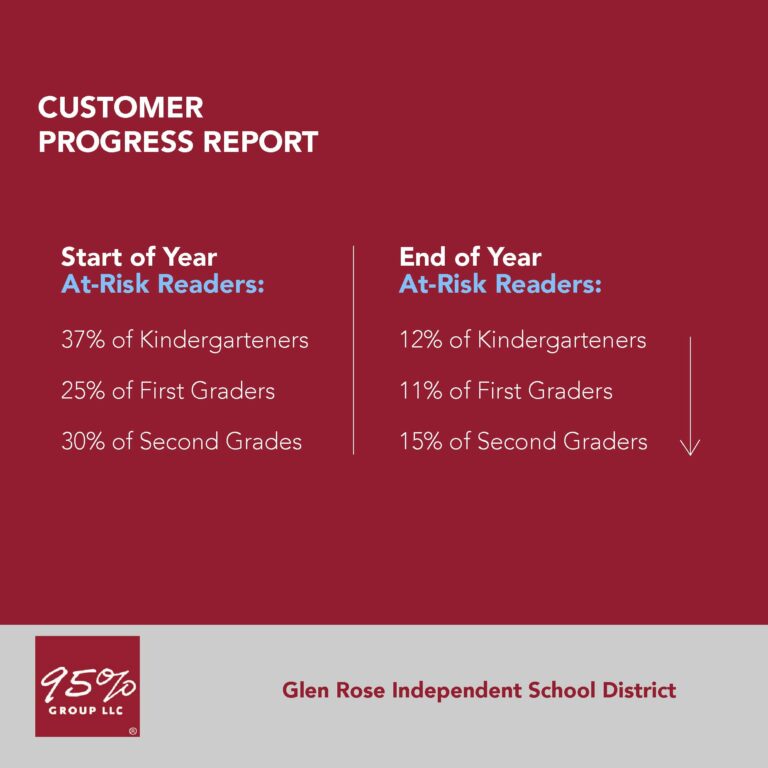Spotlight Texas: Literacy grows in Glen Rose

About the school district
Glen Rose Independent School District is a small, rural district outside of Fort Worth, Texas. Families who live in the community are often drawn to what the district’s website calls “small town values with big time vision.” The district as a whole has close to 2,000 students and, in K-3, serves about 500 students.
“We are a caring community with a strong sense of unity that empowers and inspires students through innovative education,” said Mehgan Schuelke, an educational diagnostician and reading specialist for Glen Rose.
Challenge
Recently House Bill 3 was passed in the state of Texas, requiring that all districts shift to a phonics-based curriculum for reading instruction. All K–3 teachers and principals must complete the state’s professional learning program, “Reading Academies,” by 2023, for guidance on implementing the science of reading in their classrooms. The science of reading is at the center of a growing movement in education that calls for more effective reading instruction. Its evidence-based approach helps educators develop students’ literacy skills through phonics instruction.
“We were seeing a real lack of growth in reading skills among students,” said Schuelke. “We knew something needed to change.”
Solution
As they began preparing for the shift to phonics in the fall of 2021, Schuelke worked with her curriculum director to create a rubric for their new method of instruction, structured literacy, and determine the resources they needed to support their new criteria. After a review of options, they chose 95 Percent’s Phonics Core Program™ for whole-class instruction, along with 95 Phonological Awareness Screener for Intervention™ and 95 Phonics Screener for Intervention™.
“The key things our rubric called for were explicit teaching practices and progress monitoring,” said Schuelke. “95 Percent Group’s offerings met all the criteria we needed and provided turnkey solutions for students at different stages of their reading journey.”
Result
In 2021–2022, many students had started school with below average literacy skills. Schuelke and her colleagues, therefore, planned to assess students as quickly as possible and place them into intervention groups, as appropriate.
“Using the 95 Percent Group assessments was efficient and effective,” she said “Actually this is the first time I have seen phonics assessments used in such a consistent, successful way.”
During the year, they wanted to progress as many students as possible from intervention into whole class instruction. And they did.
“So many of our second grade teachers said to me midyear: “Oh my gosh, this is working!” said Schuelke.
By the end of the year, they had reached another important benchmark.
“By June, we had more than 85% of our second graders students in Tier 1, whole-class instruction. This is such a critical learning year for kids, and we had a lot of ground to make up after the pandemic’s disruptions. We were thrilled to reach this goal,” she said.
Advice for other educators
Change is not always easy in school, especially when teachers have been doing something a certain way for a while. They don’t like feeling as though they are “experimenting” with their students’ education, especially when it comes to something as critical as reading.
“Teachers can be hesitant when it comes to change,” she said. “Show your teachers the evidence that this structured literacy approach works. Have them talk to another teacher from another school. Get them the training they need. At the end of the day educators are learners too. So help us learn, and give us great resources.”
From there, it didn’t take too much more convincing at Glen Rose.
“Our teachers accepted this new approach quickly and really enjoyed it. They saw the progress their students were making clearly and quickly,” she said.
The specific breakdown of improvement was remarkable. In the beginning of the year, they had 37% of kindergarteners, 25% of first graders, and 30% of second grades identified as at-risk readers. By the end of the year, those numbers had changed dramatically: only 12% of kindergarteners, 11% of first graders, and 15% of second graders were at risk.
Closing thoughts
Schuelke commented that one of the best aspects of working with 95 Percent Group is that its suite of offerings is “cohesive and consistent.” Once the teacher and student know the routine from using one of the reading products, they and their students can move seamlessly into using another of the company’s offerings. The products are all designed to work together intentionally in an “ecosystem,” with each one offering a consistent structure for instruction and learning.
“This means less time going over the rules of the game, and more time focusing on the actual learning experience,” she said.
And her final, closing thought?
“Reading should be a joyful experience for students,” she said. “And this is.”
Learn more
Are you interested in learning about how you can bring an effective and efficient structured literacy approach, grounded in the science of reading, to your school or district? Contact us today.




